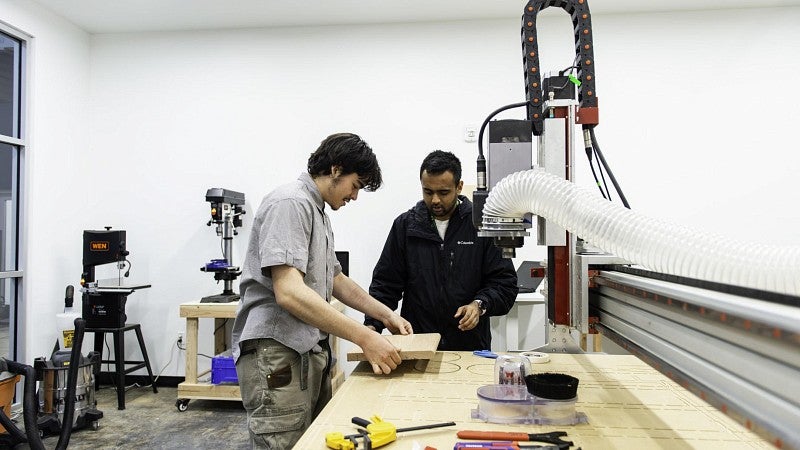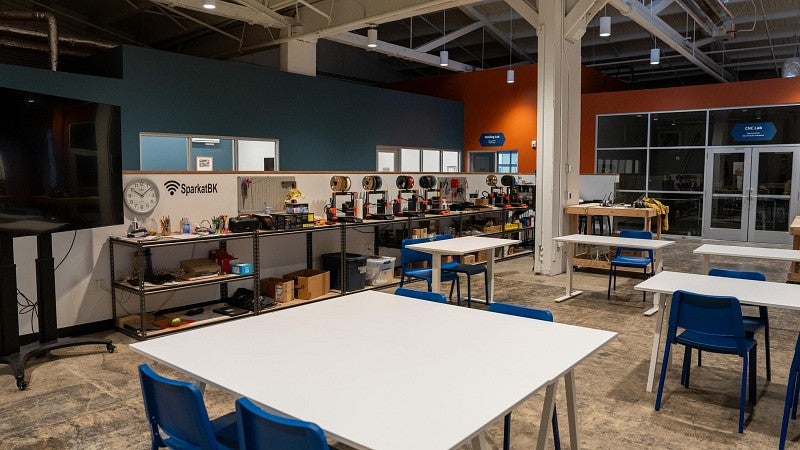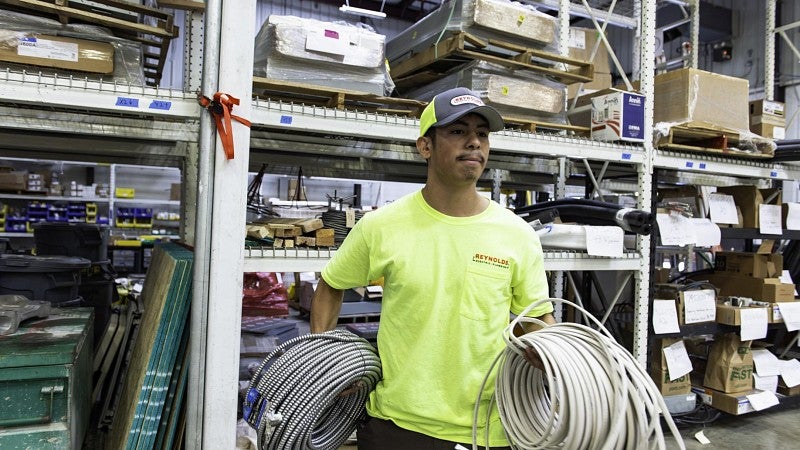Christopher Murray, a University of Oregon education professor, is facing an opportunity and a challenge unlike any in his 25-year career.
With help from a $10 million U.S. Department of Education grant, he and his project collaborators are trying to revamp the way youth with disabilities, age 18 to 24, prepare for and join the workforce.
Working with community partners that already serve youth, the UO team will develop and implement a model in Lane County, which will then be expanded to two other Oregon regions.
"Our overall goal is to successfully get 1,900 youth with disabilities stable jobs in typical employment settings while documenting how we do it, so the model can be transported to other communities," said Murray, a professor in the UO's Department of Counseling Psychology and Human Services in the College of Education.
He's both elated by the possibility and daunted by the challenge the grant presents. Despite a series of multimillion-dollar federal efforts, the unemployment rate for adults with disabilities is 7.6 percent, more than double the 3.5 percent unemployment rate for adults without disabilities.
"The population of individuals with disabilities that this project seeks to reach, those with significant disabilities, experience even higher unemployment and are one of the most disenfranchised communities in the United States," Murray said.


Training up young workers with disabilities
In the next five years, Murray and the team at the College of Education will collaborate with community partners - nonprofit groups, schools, businesses and state agencies - to evaluate existing school-to-work programs in Lane County and enhance them to serve more youth with intellectual and developmental disabilities.
After refining the model in Lane County, which includes Eugene-Springfield, the team will then take it to Oregon's High Desert region near Bend and Linn and Benton counties near Corvallis. They will work with partners in each region to create variations of the Lane County model. They intentionally included rural communities because the challenges youth face in urban areas often are amplified in rural communities with fewer people, training opportunities and jobs.
Understanding that perceptions must change if outcomes are to change, the UO team also will design short, online trainings for educators, community-based organizations, employers and the families of youth with disabilities. The trainings will show that youth with disabilities can be successful, valuable members of any business or organization when they are provided with opportunities to contribute.
"One of the unique features of our model is that we bring youth, educators, community-based organizations and employers together around projects that provide direct benefits to communities," Murray said. "This approach provides youth with hands-on, work-based learning experiences with educators and employers who are invested in supporting a community need."
Ultimately, the UO team will give away their program blueprints and training modules to any community that wants to set up something similar for its youth.


Connecting with community partners
"I have done a lot of research projects in my life, and I honestly am very excited about the possibilities of this one," Murray said. "I really believe in this one."
His faith stems from his confidence in community partners that already are providing valuable learning and employment experiences to Lane County youth. Examples include the nonprofit organization Connected Lane County, the Eugene School District, Lane Educational Service District and Pivot Architecture. The Eugene-based architecture firm has partnered with school districts throughout Lane County to design and deliver programs such as Team Oregon Build, which introduces youth to construction careers through building transitional shelters and other structures in regions affected by wildfires and homelessness.
"You need all of these groups," Murray said. "They can combine their ideas and resources in ways that education can't alone. It's synergistic."
Many of the partners have collaborated for years through Lane Workforce Partnership, the local workforce board in the Lane County area.
"These community partners have already shown proof of concept," Murray said. "Now it's a matter of studying and documenting the efforts, modifying them to include more youth with disabilities and continuing to expand relationships with industry partners."
All regions throughout the country have local workforce boards that work in parallel with economic development boards. A federally funded structure exists throughout the U.S. to share and expand the ideas to be incubated, tested and proven in Lane County.



Connected Lane County: The 'perfect partner'
The UO team will subcontract with numerous community partners that deliver services to youth. A key collaborator in the proposal is the Eugene-Springfield-based nonprofit Connected Lane County, which Murray calls the "perfect partner."
Founded in 2014, Connected Lane County is backed by early childhood partners, school districts, higher education institutions, businesses and the regional workforce board. Today the group serves more than 3,000 youth age 14 to 24 every year.
With facilities in downtown Eugene and at the former Booth-Kelly mill site in nearby Springfield, Connected Lane County offers a range of programs and wraparound supports to help youth explore careers, gain confidence in their abilities, and connect with learning and employment opportunities that can change their lives. Wraparound supports might include transportation to the program, referrals to behavioral health resources or financial education about setting and sticking to a budget.
Last year, Connected Lane County launched three "excelerators" - a word blending the concepts of excel and accelerator - to offer young people training and hands-on experience in health care, manufacturing and technology.
"We've looked across the country and haven't found something quite like us," said Heidi Larwick, Connected Lane County's executive director. "The components exist in other communities. They just haven't been working together in a way that maximizes resources as nonprofits."



Real-world work in the excelerators
Connected Lane County will receive $2.5 million from the UO grant over five years, which will enable the group to hire additional staff, provide more support and services to youth with disabilities and launch a fourth excelerator focused on the culinary and hospitality field. Along with teaching about food preparation and handling, the new excelerator will emphasize the communication and customer service skills that lay the foundation for nearly all jobs.
"If you were lucky enough to get a job as a teenager, often it was in food service," Larwick said, adding that her first job was as a restaurant hostess.
Having led Connected Lane County for the past decade, Larwick has witnessed the gap in support for young adults age 18-24, regardless of their path into college or the workforce. The challenges are even greater for young people with disabilities, who've increasingly sought services from Connected Lane County, she said.
"We've done our best to make accommodations in the moment for youth who needed them, but the UO grant will enable us to do so much more," Larwick said.
Connected Lane County will hire two specialists to increase the program's capacity to serve individuals with disabilities.
"We definitely have a model that others could learn from because we're pulling from resources that exist in every area, including rural communities," Larwick said. "There are workforce investment boards across the country and access to internship dollars. There is economic development money in every county. We're hoping to show people, here's a way you can use these funding sources together in a very impactful, meaningful way."
The UO will contribute its knowledge about disability and technical expertise to create free online professional development for educators, community-based organizations, industry partners and the families or caregivers of youth with disabilities.
"The UO's name and position in the community and state will benefit getting this work out there and into the hands of more communities," Larwick said.

The power of opportunity: Education and careers
Before earning his doctorate, Murray worked as a counselor in a youth shelter and as a special education teacher in middle and high schools.
Today, his research focuses on social supports for youth with disabilities and the transition from adolescence to adulthood.
"Society does not find spaces and places to include people with significant disabilities," Murray said. "As a result they're living on the fringes and alienated from employment, postsecondary education and full engagement in their communities."
Murray is driven to do that work by his desire to create more opportunities for young people.
That resonates personally for Murray because of his experiences growing up in a low-income community and the challenges he experienced, including dropping out of high school and later earning his GED.
"I've seen struggle," Murray said. "I've seen how difficult it can be to have opportunities, but I've also seen how incredibly valuable opportunities can be. For me personally, access to caring adults and new experiences was absolutely life-changing."
The new project Murray is embarking on has research components to it as well.
"But in the end," he said, "it is about helping young people who often lack opportunity, get new opportunities to be more fully included within their communities."
Oregon project is part of national effort to support workers with disabilities
The $10 million grant to Christopher Murray, a professor at the University of Oregon College of Education, is part of a broader national effort to improve employment outcomes among people with disabilities.
The U.S. Department of Education recently awarded $251 million to 27 grantees across the country. They were selected from more than 200 applicants. The UO was the only grant recipient on the West Coast.
"Today, more than 60 million adults live with a disability - each with unique talents and strengths," U.S. Secretary of Education Miguel Cardona said in the award announcement. "In our 21st century economy, we must provide more opportunities for these individuals to achieve their goals for competitive integrated employment, independence, and economic self-sufficiency. Through the Disability Innovation Fund and today's announcement, we'll make progress to overcome historic barriers to employment, while ensuring the varied needs, preferences, and goals of individuals with disabilities remain at the center of our vision for a strong, inclusive workforce."
The funding agency and reviewers liked the UO's entire plan, Murray said.
"They were very intrigued by the collective impact model that has employers, the regional workforce board, state and community agencies, education systems and families working together on specific projects that provide direct benefits to communities," he said. "There aren't a lot of examples of that around the country. We're eager to share the model we develop in Lane County with other communities to improve employment opportunities for youth with disabilities."








